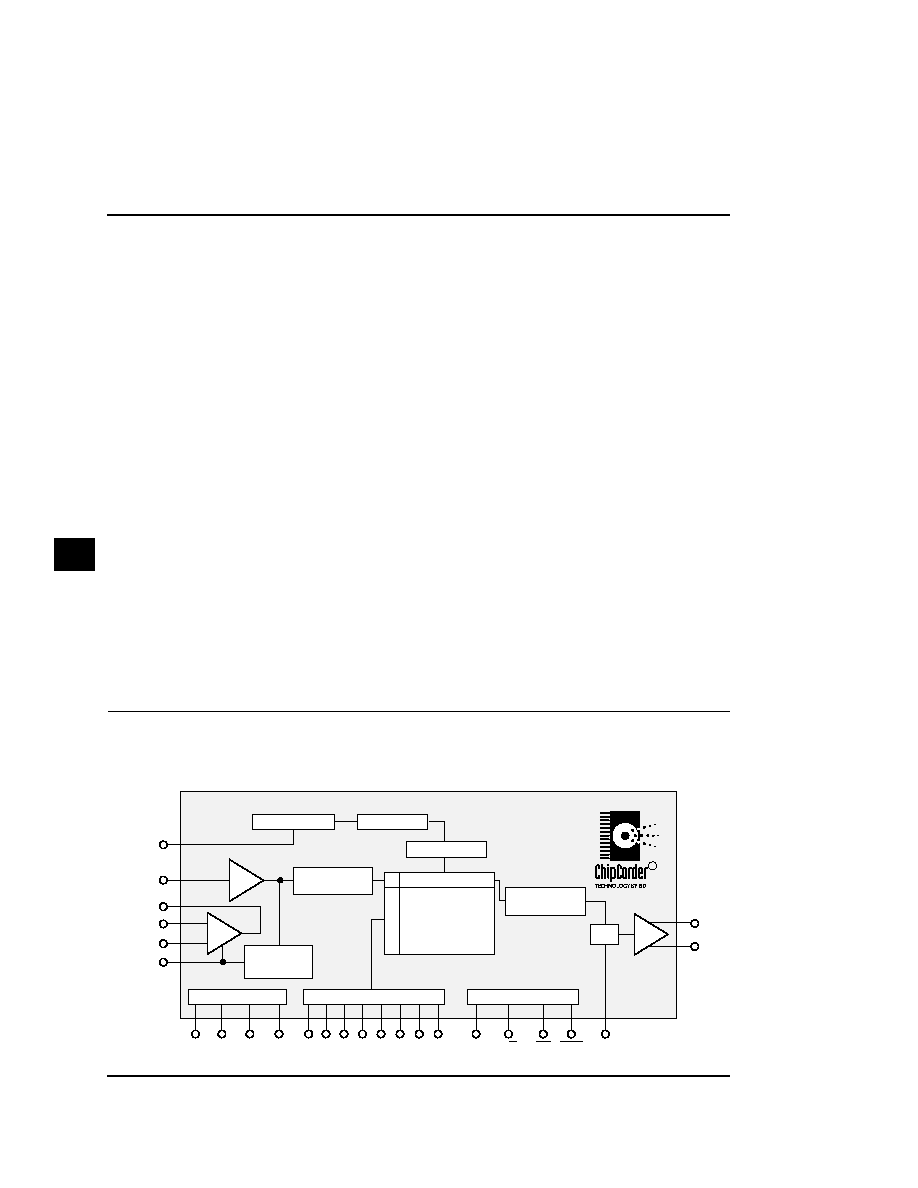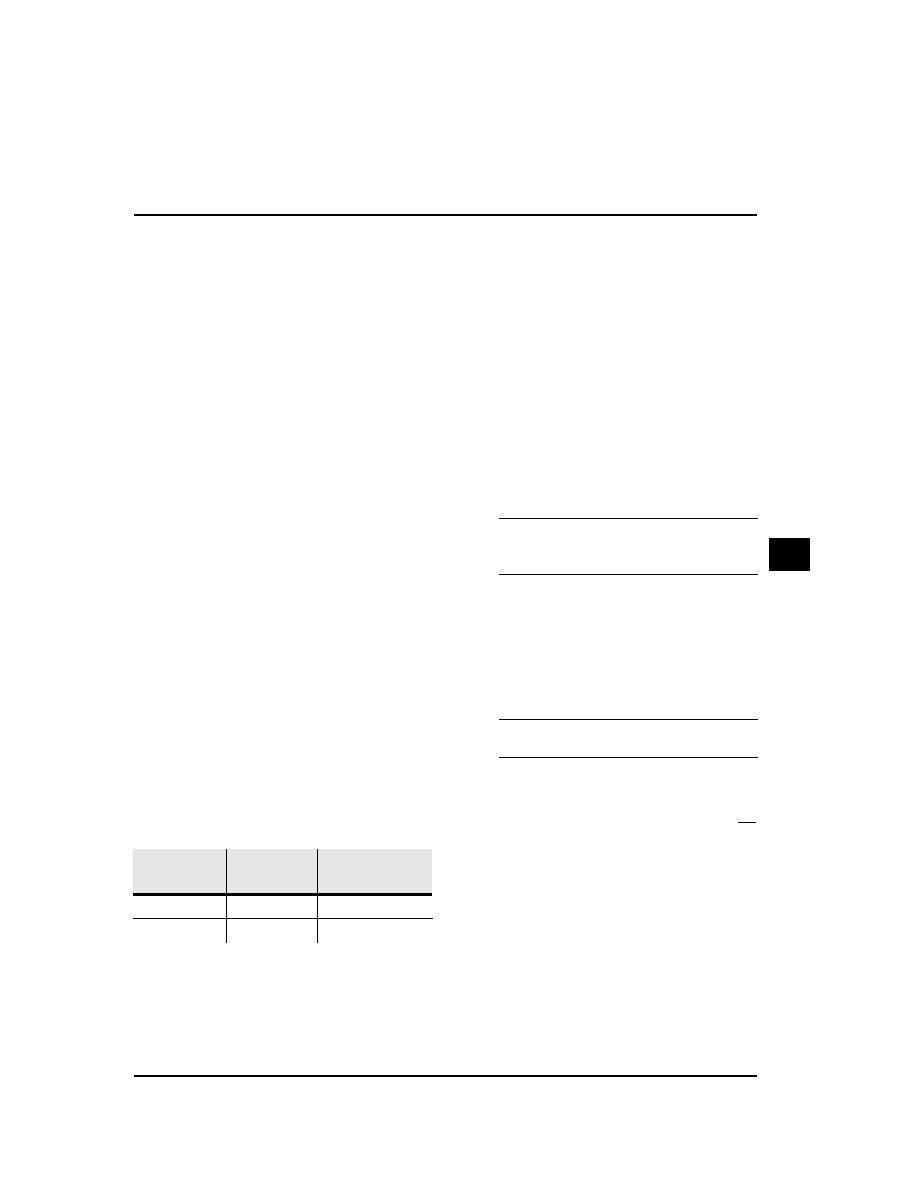 | –≠–ª–µ–∫—Ç—Ä–æ–Ω–Ω—ã–π –∫–æ–º–ø–æ–Ω–µ–Ω—Ç: ISD1016AP | –°–∫–∞—á–∞—Ç—å:  PDF PDF  ZIP ZIP |

1≠1
Information Storage Devices, Inc.
1
Æ
FEATURES
∑
Easy-to-use single-chip voice Record/Play-
back solution
∑
High-quality, natural voice/audio
reproduction
∑
Manual switch or microcontroller compatible
≠
Playback can be edge- or level-
activated
∑
Single-chip durations of 16 and 20 seconds
∑
Directly cascadable for longer durations
∑
Power-down mode
≠
1
µ
A standby current (typical)
∑
Zero-power message storage
≠
Eliminates battery backup circuits
∑
Fully addressable to handle multiple
messages
∑
100-year message retention (typical)
∑
100,000 record cycles (typical)
∑
On-chip clock source
∑
No algorithm development required
∑
Single +5 volt supply
∑
Available in die form, DIP, and SOIC
packaging
∑
Industrial temperature (-40
∞
C to +85
∞
C)
version available
ISD1000A Series
Single-Chip Voice Record/Playback Devices
16- and 20-Second Durations
ISD1000A SERIES SUMMARY
Part
Number
Duration
(Seconds)
Input Sample
Rate (KHz)
Typical Filter
Pass Band
(KHz)
ISD1016A
16
8
3.4
ISD1020A
20
6.4
2.7
06.DataBook_1000A Dsht Page 1 Friday, September 27, 1996 10:44 AM

Product Data Sheets
ISD1000A Series
1≠2
-
1
GENERAL DESCRIPTION
Information Storage Devices' ISD1000A Chip-
Corder
Æ
Series provides high-quality, single-chip
record/playback solutions for 16- and 20-second
messaging applications. The CMOS devices
include an on-chip oscillator, microphone pream-
plifier, automatic gain control, antialiasing filter,
smoothing filter, and speaker amplifier. In addi-
tion, the ISD1000A Series is fully microprocessor-
compatible, allowing complex messaging and
addressing to be achieved.
Recordings are stored in on-chip nonvolatile
memory cells, providing zero-power message
storage. This unique, single-chip solution is made
possible through ISD's patented multilevel stor-
age technology. Voice and audio signals are
stored directly into memory in their natural form,
providing high-quality, solid-state voice reproduc-
tion.
DETAILED DESCRIPTION
The ISD1000A ChipCorder Series devices are
designed to Record and Play back audio and
voice information in a single chip with a minimum
of circuit complexity. This compact, easy-to-use,
nonvolatile, low-power solution has been made
possible by ISD's multilevel storage technology --
a breakthrough in storage technology in EEPROM.
ISD's multilevel storage technology results in stor-
age density that is eight times greater than digital
memory. The ISD1000A nonvolatile analog array
consists of 128K cells -- the equivalent of 1 Mbits
of digital storage.
The ISD1000A Series eliminates the need for dig-
ital conversion, digital compression, and voice
synthesis techniques which often compromise
voice quality and are more complicated to use.
The ISD1000A Series includes signal conditioning
circuits and control functions which enable a com-
plete, high-quality Recording and Playback sys-
tem in a single device. The ISD1000A is available
in two versions, which store voice in 16- or 20-sec-
ond arrays. Additional devices may be cascaded
ISD1000A SERIES BLOCK DIAGRAM
Amp
Timing
Internal Clock
Pre-
Amp
V
CCA
V
CCD
Power Conditioning
A0
A2 A3 A4 A5
A7
A6
Address Buffers
ANA IN
ANA OUT
MIC
MIC REF
AGC
Analog Transceivers
Decoders
128 K Cell
Nonvolatile
Multilevel Storage
Array
Amp
Sampling Clock
PD
P/R
CE
EOM
Device Control
XCLK
AUX IN
SP+
SP≠
Mux
V
SSA
V
SSD
A1
Automatic
Gain Control
(AGC)
5-Pole Active
Antialiasing Filter
5-Pole Active
Smoothing Filter
R
06.DataBook_1000A Dsht Page 2 Friday, September 27, 1996 10:44 AM

Product Data Sheets
ISD1000A Series
1≠3
1
to achieve longer recording durations. The non-
volatile storage array is based on production-
proven, low-power CMOS EEPROM technology.
The highly integrated ISD1000A Series contains
all the basic functions required for high-quality
voice Recording and Playback. The noise-cancel-
ling Microphone Preamplifier and Automatic Gain
Control (AGC) record both low-volume and high-
volume sounds. The AGC attack and release
times are adjusted by an external resistor and
capacitor. Antialiasing is performed by a continu-
ous fifth-order Chebyshev filter, requiring no exter-
nal components or clocks to give toll-quality
reproduction. The low corner of the passband is
user-settable by two external capacitors. The
devices contain their own temperature-stabilized
timebase oscillator.
The ISD1000A devices drive a speaker directly
through differential outputs. This boosts power by
four times and eliminates the need for a series
capacitor or an output amplifier. The device will
operate from a single power supply or from batter-
ies. The device also includes a power down func-
tion for applications where minimum power
consumption is critical. The CMOS-based design,
combined with the nonvolatile storage array,
assures the lowest possible overall power con-
sumption.
On-chip control functions make the ISD1000A
Series very easy to use in a wide array of applica-
tions. Each device offers a variety of operating
modes and interface options. The devices may be
used in applications that require little more than a
few switches and a battery. The devices may also
be integrated into electronic systems where digital
addresses can be provided for more sophisti-
cated message addressing and control. The
ISD1000A array is organized into 160 segments.
Addresses A0 through A7 provide access to each
segment in the array for message addressing.
Addressing provides the capability of construct-
ing messages by combining stored phrases and
sounds.
PIN DESCRIPTIONS
Voltage Inputs (V
CCA
, V
CCD
)
To minimize noise, the analog and digital circuits
in the ISD1000A Series devices use separate
power busses. These voltage busses are brought
out to separate pins and should be tied together
as close to the supply as possible. In addition,
these supplies should be decoupled as close to
the package as possible.
Ground Inputs (V
SSA
, V
SSD
)
The ISD1000A Series of devices utilizes separate
analog and digital ground busses. These pins
should be tied together as close to the package
as possible and connected through a low-imped-
ance path to power supply ground.
Power Down Input (PD)
When not recording or playing back, the PD pin
should be pulled HIGH to place the part in a very
low power mode (see I
SB
specification). When
EOM pulses LOW for an overflow condition, PD
should be brought HIGH to reset the address
pointer back to the beginning of the Record/Play-
back space.
SSD
SSA
M0/A0
M1/A1
M2/A2
M3/A3
M4/A4
M5/A5
NC
NC
A6
A7
AUX IN
V
V
SP+
V
P/R
XCLK
EOM
PD
CE
NC
ANA OUT
ANA IN
AGC
MIC REF
MIC
V
SP≠
CCD
CCA
DIP/SOIC
1
2
3
4
5
6
7
8
9
10
11
12
13
14
28
27
26
25
24
23
22
21
20
19
18
17
16
15
ISD1000A SERIES PINOUTS
06.DataBook_1000A Dsht Page 3 Friday, September 27, 1996 10:44 AM

Product Data Sheets
ISD1000A Series
1≠4
-
1
Chip Enable Input (CE)
The CE pin is taken LOW to enable all Playback
and Record operations. The address inputs and
Playback/Record input (P/R) are latched by the
falling edge of CE. When CE is taken HIGH, the
ISD1000A is unselected, the P/R is HIGH, and the
auxiliary input is directed into the speaker ampli-
fier.
Playback/Record Input (P/R)
The P/R input is latched by the falling edge of the
CE pin. A HIGH level selects a Playback cycle
while a LOW level selects a Record cycle. For a
Record cycle, the address inputs provide the
starting address and recording continues until PD
or CE is pulled HIGH or an overflow is detected
(i.e. the chip is full). When a Record cycle is termi-
nated by pulling PD or CE HIGH, an End-Of-Mes-
sage (EOM) marker is stored at the current
address in memory. For a Playback cycle, the
address inputs provide the starting address and
the device will play until an EOM marker is
encountered. The device can continue past an
EOM marker in an operational mode, or if CE is
held LOW in address mode. (See page 1-6 for
more Operational Modes).
End-Of-Message Output (EOM)
A non-volatile marker is automatically inserted at
the end of each recorded message. It remains
there until the message is recorded over. During
Playback, the EOM output pulses LOW for a
period of T
EOM
at the end of each message, or in
the event of a message overflow (device full).
In addition, the ISD1000A Series has an internal
V
CC
detect circuit to maintain message integrity
should V
CC
fall below 3.5V. In this case, EOM
goes LOW and the device is fixed in Playback-
only mode. The EOM marker provides a conve-
nient handshake signal for a processor, and also
facilitates the cascading of devices.
Microphone Input (MIC)
The microphone input transfers its signal to the
on-chip preamplifier. An on-chip Automatic Gain
Control (AGC) circuit controls the gain of this
preamplifier from -15 to 24 dB. An external micro-
phone should be AC coupled to this pin via a
series capacitor. The capacitor value, together
with the internal 10 Kohm resistance on this pin,
determines the low-frequency cutoff for the
ISD1000A Series passband. See ISD's Applica-
tion Notes and Design Manual in this book for
additional information on low-frequency cutoff cal-
culation.
Microphone Reference Input (MIC REF)
The MIC REF input is the inverting input to the
microphone preamplifier. This provides a noise-
canceling or common-mode rejection input to the
device when connected to a differential micro-
phone.
IF
THIS
INPUT
IS
UNUSED
,
IT
MUST
BE
LEFT
DISCONNECTED
.
Automatic Gain Control Input (AGC)
The AGC dynamically adjusts the gain of the
preamplifier to compensate for the wide range of
microphone input levels. The AGC allows the full
range of whispers to loud sounds to be recorded
with minimal distortion. The "attack" time is deter-
mined by the time constant of a 5 K
internal
resistance and an external capacitor (C2) con-
nected from the AGC pin to V
SSA
analog ground.
The "release" time is determined by the time con-
stant of an external resistor (R2) and an external
capacitor (C2 on the schematic on page 1-17)
connected in parallel between the AGC Pin and
V
SSA
analog ground. Nominal values of 470 K
and 4.7
µ
F give satisfactory results, in most cases.
For AGC voltages of 1.5V and below, the pream-
plifier is at its maximum gain of 24 dB. Reduction
in preamplifier gain occurs for voltages of approx-
imately 1.8V.
06.DataBook_1000A Dsht Page 4 Friday, September 27, 1996 10:44 AM

Product Data Sheets
ISD1000A Series
1≠5
1
Analog Output (ANA OUT)
This pin provides the preamplifier output to the
user. The voltage gain of the preamplifier is deter-
mined by the voltage level at the AGC pin. It has a
maximum gain of about 24 dB for small input sig-
nal levels.
Analog Input (ANA IN)
The analog input pin transfers its signal to the chip
for recording. For microphone inputs, the ANA
OUT pin should be connected via an external
capacitor to the ANA IN pin. This capacitor value,
together with the 2.7 K
input impedance of ANA
IN, is selected to give additional cutoff at the low-
frequency end of the voice passband. If the
desired input is derived from a source other than
a microphone, the signal can be fed, capacitively
coupled, into the ANA IN pin directly.
Optional External Clock Input (XCLK)
ISD1000A devices are configured at the factory
with an internal sampling clock frequency cen-
tered to
±
1% of specification. The frequency is
maintained to a total variation of
±
2.25% toler-
ance over the entire commercial temperature and
4.5 to 5.5 voltage ranges. The internal clock has a
±
5% tolerance over the industrial temperature
range and 4.5 to 5.5 voltage range. A regulated
power supply is recommended for industrial-tem-
perature-range parts. If greater precision is
required, the device can be clocked through the
XCLK pin as follows.
These recommended clock rates should not be
varied because the antialiasing and smoothing fil-
ters are fixed, and aliasing problems can occur if
the sample rate differs from the one recom-
mended. The duty cycle on the input clock is not
critical, as the clock is immediately divided by
two.
IF
THE
XCLK
IS
NOT
USED
,
THIS
INPUT
MUST
BE
CONNECTED
TO
GROUND
.
Speaker Outputs (SP+/SP-)
All devices in the ISD1000A Series include an on-
chip differential speaker driver, capable of driving
50 milliwatts into 16
from AUX IN (12.2 mW from
memory).
The speaker outputs are held at V
SSA
levels during
record and power down. It is therefore not possi-
ble to parallel speaker outputs of multiple
ISD1000A devices or the outputs of other speaker
drivers.
NOTE
Connection of speaker outputs in parallel
may cause damage to the device.
While a single output may be used alone (includ-
ing a coupling capacitor between the SP pin and
the speaker), these outputs may be used individ-
ually with the output signal taken from either pin.
Using the differential outputs results in a 4:1
improvement in output power.
NOTE
Never ground or drive an output.
Auxiliary Input (AUX IN)
The Auxiliary Input is multiplexed through to the
output amplifier and speaker output pins when CE
is HIGH and Playback has ended, or if the device
is in overflow. When cascading multiple ISD1000A
devices, the AUX IN pin is used to connect a Play-
back signal from a following device to the
previous output speaker drivers. For noise consid-
erations, it is suggested that the Auxiliary Input not
be driven when the storage array is active.
Address/Mode Inputs (Ax/Mx)
The Address/Mode Inputs provide two functions in
the ISD1000A Series: 1. Message address (either
Part
Number
Sample Rate
Required Clock
ISD1016A
8.0 KHz
1024 KHz
ISD1020A
6.4 KHz
819.2 KHz
06.DataBook_1000A Dsht Page 5 Friday, September 27, 1996 10:44 AM




